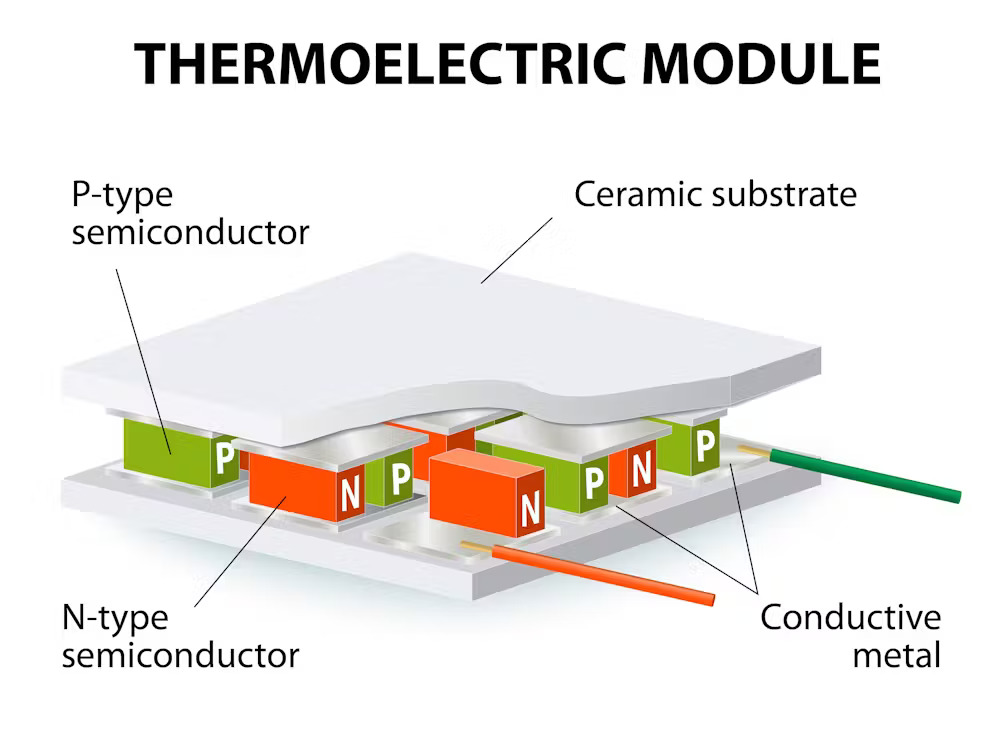Analysis: Thermoelectric technologies can help power a zero-carbon future

Flares burn at the Shell Norco Manufacturing Complex in 2021, in Norco, La. Plants like this produce not only greenhouse gas emissions, but also excess heat. (AP Photo/Gerald Herbert)
BY Chun-wan Timothy Lo
February 22, 2024
![]() This article is republished from The Conversation under a Creative Commons license. Read the original article.
This article is republished from The Conversation under a Creative Commons license. Read the original article.
Thermometers are an under-appreciated marvel of human ingenuity built upon an understanding of relatively simple physical principles. Mercury and alcohol thermometers rely on the volume of liquids growing or shrinking in reaction to temperature change. Contactless infrared thermometers, by contrast, read the thermal radiation emitted by any object, from frying pans to the human body.
While digital thermometers, such as infrared, are a relatively recent invention other types have been around for hundreds of years.
There is, however, another type of digital thermometer known as a thermocouple. Thermocouples are commonly used in industrial applications and leverage a natural phenomenon whereby the meeting of two different temperatures generates electrical current. This principle can be used both to measure temperatures and, more excitingly, to actually harvest useful electricity from everyday temperature changes. I am part of a team working to help make this technology a practical reality.
Thermoelectric
In 1821, German physicist Thomas Johann Seebeck observed that a nearby magnetic compass needle was deflected by a closed electrical circuit made of two different metals. Two years later, physicists Hans Christian Ørsted and Jean Baptiste Joseph reported that the interaction of the two metals, once connected in a circuit, had generated an electrical current because one was warmer than the other.
This physical phenomenon was later named the Seebeck Effect.
Interestingly, Italian physicist Alessandro Volta — in whose honour the term volt is named — had observed and explained the same phenomenon in 1794 using nerves from a dead frog. Volta generated an electric current using a metal wire, two glasses of water (each at a different temperature) and the nerves of the frog as an electrical bridge.
A grisly image, but one which foreshadowed future scientific breakthroughs.

Excited at the possibilities, scientists worked to exploit the findings by making and harvesting useful amounts of electric current simply by connecting two materials at different temperatures. Today we call this thermoelectricity, and we still use it in very specific contexts.
NASA has utilized the advantages of thermoelectric technology to make deep space exploration possible by coupling thermoelectric generators with radioactive material as the fuel.
Launches using radioisotope thermoelectric generators include the Curiosity Mars rover in 2011, the Perseverance in 2020, and the planned launch of the Dragonfly in 2027 to Saturn’s moon Titan.
This piece of technology even breached the realm of popular culture as a result of its central role in the 2011 novel — and later film of the same name — The Martian by Andy Weir.
Closer to home
Here on Earth, thermoelectric generators have been used in remote areas to generate electricity. For example, a small thermoelectric module, connected to a portable boiler or stove, can charge your phone while you’re camping at the expense of fuel. This is but a small example; thermoelectric devices could do much more.
Human societies make excessive amounts of heat through numerous processes from cooking, industrial activity to even air conditioning and refrigeration. After these processes are finished, almost all of this heat dissipates without capturing the electricity it could provide.
Read more: Why we need to reuse waste energy to achieve net-zero heating systems
For example, only about one-third of the energy produced in a gasoline-powered car is used while the other two-thirds is lost as heat. That lost heat could be captured to power thermoelectric devices, which would dramatically improve fuel efficiency.
We could do the same in factories and in many other places where heat is a wasted by-product of another function. And building these systems would help us reach our net-zero target by 2050.
So, why on Earth (literally) are we not using thermoelectrics to recycle wasted heat?
Simply put, a thermoelectric device requires a material which must conduct electricity well and conduct heat poorly. Without these characteristics the temperature difference, and generative potential, between the two sides of the device will not be maintained.
Copper wire, for example, conducts electricity very well but also is an excellent heat conductor. These qualities make for great wire but also leaves copper as a poor candidate in this application.
Building the materials
The ideal materials for thermoelectricity do not exist naturally. As such, the priority in the field of thermoelectric research is to create materials that are both efficient and inexpensive, so they can be mass-produced and widely applied — ideally at minimal resource cost.
Some known thermoelectric material candidates include lead, however, its toxicity and environmental impacts rules it out as a viable candidate. More benign alternatives must be found.
Along with my colleagues at McMaster University, I am working with industrial partners to help develop cheaper, more reliable new materials. Central to this is understanding the changes in performance between various materials. We hope to develop materials which perform well both in the lab, and at scale.
All too often electricity is discussed in terms of how we can generate more. We need more plants, more fuel, more solar — more everything. We suggest that this is only half the picture. We must also learn to smartly utilize all stages of the energy life-cycle to not just generate but also store, and use thermoelectric technology to capture the electricity in that wasted heat.
Only by doing this can we truly make a more efficient power grid and help drive a carbon-free future.
Chun-wan Timothy Lo, McCall MacBain Postdoctoral Fellow, Department of Chemistry and Chemical Biology, McMaster University
This article is republished from The Conversation under a Creative Commons license. Read the original article.


